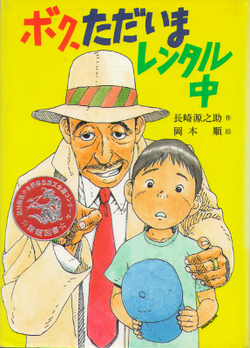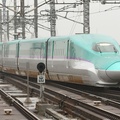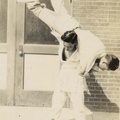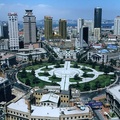You can also find Japanese people in Japanese children's literature . I myself have known about this work for quite some time, but for a long time I didn't pay it much attention. However, a few years ago, when I had the opportunity to learn about a study on the marriage situation of people of Korean descent in Japanese society , I suddenly remembered this work.
"I'm Renting Now" was published by Poplar Publishing in November 1992 by author Nagasaki Gennosuke (1924-2011) . The following year, the work was selected as a required reading for the 39th National Youth Book Review Contest1 .
The main characters of this work are the protagonist, sixth-grade elementary school student Inoue Kazuya, and Yumeno Magoichirou, also known as Hanamura Kenji, who holds the most important key to the development of the story .
The story begins when Yumeno, who was planning to send out elementary school children as "rental grandchildren" to provide emotional support to elderly people , calls out to Kazuya, who was playing alone in the park, and hires him as a "rental grandchild" under the pretext of a summer vacation part-time job . During the summer vacation, Kazuya gets the opportunity to learn about the pasts of various elderly people as a "rental grandchild."
The common thread among the elderly people Kazuya meets is the war. He meets a Hiroshima atomic bomb victim, a former teacher who sent many children to the battlefield under the propaganda of "One Hundred Million Fireballs," and a Korean grandfather who suffered racial discrimination at the hands of the Japanese , and hears many of their stories.
The person we will be focusing on here is Akiko, a Japanese woman whom Kazuya met.
Meeting Akiko
One day, Yumeno introduced Kazuya to an elderly woman, as she always did . The woman was a Japanese-American grandmother named Akiko Ono. She was very plump and talkative. The two met at a station in Tokyo, and took the Toden Arakawa Line to the Koshinzuka stop near the Togenuki Jizo, heading for the town of Sugamo, known as "Grandma's Harajuku."
Akiko was born in Japan, but grew up in the suburbs of San Francisco, California . As an adult in the United States, she got married and was blessed with children. However, as a result of the outbreak of war in 1941, she and her family were forced to leave San Francisco, where they had lived for a long time, and were placed in the Topaz internment camp in Utah. Life in Topaz, where sandstorms blew almost every day, was extremely difficult.
Following her internment, she suffered further tragedy when her beloved son, Susumu, died of pneumonia - it was impossible to provide him with adequate medical treatment in the detention facility, which lacked medical equipment and medicines .
She told Kazuya about what happened at that time as follows:
"Susumu: Ah, that boy, who was supposed to be immortal, died like a pig in that camp. No, you could say he was murdered. Killed by the Japanese army and the Americans . The boy had collapsed in the sandstorm and developed pneumonia, but he was not given any nutritious food or injections. He groaned in pain, and the heat sucked all the moisture out of his body, so he died. I wanted to at least give that boy plenty of water. I wanted to let him fill his lungs with clean air , untainted by the sandstorm ." 2
(*The underlined parts are added by the author.)
If there had been no war, Akiko would not have had to endure the tragedy of her beloved son's death. At the same time that she felt hatred toward the Japanese government, which had made the reckless decision to start a war , she also had extremely complicated feelings toward the American government, which had forcibly interned its own citizens on the pretext of the war with Japan .
"We had lived in America for many years and loved America. Although we were not legally eligible to become Americans, we considered America our own country , and our children were genuine American citizens . Treating us like prisoners and locking us up in camps like livestock is a huge stain on the history of American democracy . "
(*The underlined parts are added by the author.)
Kazuya listened to her story, but to be honest, he didn't find it interesting. He had no idea what was going on in a foreign country far away from Japan that he had never seen or been to, and it wasn't even of interest to him . But despite that, Akiko liked Kazuya.
What Nagasaki wanted to tell his children
Shortly before Nagasaki published this book, in 1984, the Summer Olympics were held in Los Angeles, known as the center of the Japanese American community in the United States . Around the same time, the Summer Olympics were a major reason for author Toyoko Yamazaki to serialize her novel "Two Homelands" in the magazine "Weekly Shincho" (from the June 26, 1980 issue to the August 11, 1983 issue), which depicts the tragedy of the Pacific War in which the Pacific War tore apart two second-generation Japanese American brothers and their friends and families. After that, the Japan Broadcasting Corporation (NHK) aired the historical drama "Moeyu Sanka" (1984) based on this serialized novel , and there was a trend in Japanese society that could be called a "Japanese American boom."
It is unclear whether Nagasaki was strongly aware of this "Japanese American boom" when he included Akiko, but from reading Akiko's wartime experiences described in this book, it is clear that Nagasaki spent a considerable amount of time researching the history of Japanese Americans . Not only do I highly appreciate Nagasaki's attempt to portray an accurate portrayal of Japanese Americans for children based on detailed research, but by including a Japanese American in the story, I also felt that the strong message conveyed was that war brings tragedy regardless of nationality or ethnicity .
What Nagasaki wanted to convey most to children through this story is that war not only brings tragedy to people, but also drives them insane. Nagasaki, who served in the military in mainland China, talks about war from multiple perspectives by focusing on the war experiences of ordinary people - not only Japanese people, but also Japanese Americans living in America - and clearly summarizes the threat war poses to all of humanity . Although it is children's literature, I believe it is a work for everyone .
Notes:
1. Nagasaki won the Japan Children's Writers Association Newcomer Award in 1956 for "Chakobee" and "Tokotonyare, " and the Noma Children's Literature Award in 1980 for "Wasurerareta Shima e." A complete collection of his works (20 volumes in total) was published by Kaiseisha between 1986 and 1988 .
2. Nagasaki Gennosuke, "I'm currently renting it out", page 80.
3. Nagasaki Gennosuke, "I'm currently renting it out", page 80.
© 2016 Takamichi Go






